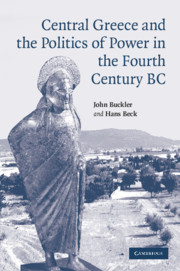Book contents
- Frontmatter
- Contents
- List of maps
- Preface
- Acknowledgments
- List of abbreviations
- Prologue
- Part I ALLIANCE
- Part II HEGEMONY
- Chapter 6 The re-establishment of the boiōtarchia (378 BC)
- Chapter 7 The battle of Tegyra, 375 BC
- Chapter 8 Plutarch on Leuctra
- Chapter 9 Alliance and hegemony in fourth-century Greece: the case of the Theban Hegemony
- Chapter 10 Xenophon's speeches and the Theban Hegemony
- Chapter 11 The phantom synedrion of the Boeotian Confederacy, 378–335 BC
- Chapter 12 Boeotian Aulis and Greek naval bases
- Chapter 13 Epaminondas and the new inscription from Cnidus
- Part III DOMINATION
- Epilogue
- Glossary
- References
- Index
Chapter 6 - The re-establishment of the boiōtarchia (378 BC)
from Part II - HEGEMONY
Published online by Cambridge University Press: 22 September 2009
- Frontmatter
- Contents
- List of maps
- Preface
- Acknowledgments
- List of abbreviations
- Prologue
- Part I ALLIANCE
- Part II HEGEMONY
- Chapter 6 The re-establishment of the boiōtarchia (378 BC)
- Chapter 7 The battle of Tegyra, 375 BC
- Chapter 8 Plutarch on Leuctra
- Chapter 9 Alliance and hegemony in fourth-century Greece: the case of the Theban Hegemony
- Chapter 10 Xenophon's speeches and the Theban Hegemony
- Chapter 11 The phantom synedrion of the Boeotian Confederacy, 378–335 BC
- Chapter 12 Boeotian Aulis and Greek naval bases
- Chapter 13 Epaminondas and the new inscription from Cnidus
- Part III DOMINATION
- Epilogue
- Glossary
- References
- Index
Summary
In 386 Agesilaus used the autonomy clause of the King's Peace to justify the dissolution of the Boeotian Confederacy. Or, in the words of Xenophon, who was hardly an admirer of Thebes, the Spartans “made the Boeotians autonomous from the Thebans.” One need not, however, take Xenophon's wording as evidence against the existence of a Boeotian Confederacy before the King's Peace. Since Xenophon was quite reluctant to acknowledge the federal principle in Boeotian politics, he routinely refers instead to Theban domination of Boeotia. Perhaps the closest he comes to admitting the existence of federalism in Boeotia is in a speech which he ascribes to Cleigenes of Acanthus (Hell. 5, 2, 16), in which the ambassador in 383 reminded the Spartans of their care not to allow Boeotia to be united. Xenophon's interpretation of the Boeotian Confederacy as a Theban Hegemony is tendentious, as is proven by the Hellenica Oxyrhynchia, which gives a less biased and more detailed picture of the Boeotian federal government and the state of political affairs in Boeotia before 386. Furthermore, the Oxyrhynchus historian indicates that the constitution that he describes no longer existed when he composed his work, and thus he provides evidence not only for the (temporary) end of Theban pre-eminence in Boeotia but also for the dissolution of the Boeotian federal government.
Naturally, the dissolution of the Boeotian Confederacy in 386 entailed the abolition of the boiōtarchia, the chief executive magistracy of the federal government.
- Type
- Chapter
- Information
- Publisher: Cambridge University PressPrint publication year: 2008



